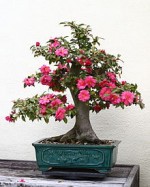 Camellias are evergreen trees or shrubs native to eastern and southern Asia. There are over 100 species of camellia including C. sinensis the plant that produces the beverage tea, and the best subject for bonsai because of its small leaves and flowers that allow it to develop into a well proportioned dwarf plant. Camellia japonica and C. susanqua are popular bonsai species, more readily available, and are the focus of this article. Most camellias bloom from late fall through early spring with white, pink, yellow, or red, single or double blossoms. Their oval leaves are shiny, dark green and leathery. Camellias can be grown in the informal upright style but large species are also suitable for the cascading style. C. japonica and C. susanqua are hardy to zones 7-8 so they need to be taken in during the winter before the first frost and put out side in spring. Take care not to move the plant when in bud as they will drop off. Bud drop can also be caused by changes in temperature or light.
Camellias are evergreen trees or shrubs native to eastern and southern Asia. There are over 100 species of camellia including C. sinensis the plant that produces the beverage tea, and the best subject for bonsai because of its small leaves and flowers that allow it to develop into a well proportioned dwarf plant. Camellia japonica and C. susanqua are popular bonsai species, more readily available, and are the focus of this article. Most camellias bloom from late fall through early spring with white, pink, yellow, or red, single or double blossoms. Their oval leaves are shiny, dark green and leathery. Camellias can be grown in the informal upright style but large species are also suitable for the cascading style. C. japonica and C. susanqua are hardy to zones 7-8 so they need to be taken in during the winter before the first frost and put out side in spring. Take care not to move the plant when in bud as they will drop off. Bud drop can also be caused by changes in temperature or light.
 Position: Place camellias in an airy, cool location, with bright light. In the summer the plant thrives in dappled morning sun and afternoon shade. In the winter it needs cool temperatures between 40°-60°F ( 50°-59°F is optimal.)
Position: Place camellias in an airy, cool location, with bright light. In the summer the plant thrives in dappled morning sun and afternoon shade. In the winter it needs cool temperatures between 40°-60°F ( 50°-59°F is optimal.)
 Water: Because camellias have fine superficial roots they should not be allowed to dry out. In order to keep the soil uniformly moist, water as soon as the surface of the soil appears dry. Plants will need less water in winter depending on the temperature. Use “soft” water as camellias do not tolerate alkalinity. Misting is appreciated.
Water: Because camellias have fine superficial roots they should not be allowed to dry out. In order to keep the soil uniformly moist, water as soon as the surface of the soil appears dry. Plants will need less water in winter depending on the temperature. Use “soft” water as camellias do not tolerate alkalinity. Misting is appreciated.
 Fertilizer: Apply a fertilizer for acid loving plants every two to three weeks after flowering, continuing on into the main growing season. Do not fertilize during the winter or when the plant is in bloom.
Fertilizer: Apply a fertilizer for acid loving plants every two to three weeks after flowering, continuing on into the main growing season. Do not fertilize during the winter or when the plant is in bloom.
 Repotting: Repot ever two to three in late winter or early spring, after flowering. Root pruning can be done at this time but should be light.
Repotting: Repot ever two to three in late winter or early spring, after flowering. Root pruning can be done at this time but should be light.
 Soil: Camellias are acid loving plants so use a mix of acidic humus-rich soil.
Soil: Camellias are acid loving plants so use a mix of acidic humus-rich soil.
 Pruning: Camellias do NOT respond well to hard pruning. Immediately after flowering or during the growing season, prune back the branches of young plants when they have developed at least four to six leaves, leaving two to three leaves in place. Light root pruning can be done yearly.
Pruning: Camellias do NOT respond well to hard pruning. Immediately after flowering or during the growing season, prune back the branches of young plants when they have developed at least four to six leaves, leaving two to three leaves in place. Light root pruning can be done yearly.
 Wiring: In late spring to autumn when branches have become woody but not brittle they can be wired taking care to proceed so that they are not damaged.
Wiring: In late spring to autumn when branches have become woody but not brittle they can be wired taking care to proceed so that they are not damaged.
 Propagation: Seed, hardwood cuttings taken from winter to summer.
Propagation: Seed, hardwood cuttings taken from winter to summer.
 Comments: Camellias are susceptible to a number of pest and disease problems including aphids, scale, red spider mites, weevils, viruses, and sooty mold.
Comments: Camellias are susceptible to a number of pest and disease problems including aphids, scale, red spider mites, weevils, viruses, and sooty mold.
To buy camellia bonsai from Amazon.com click here.
